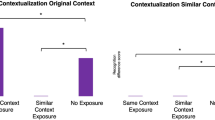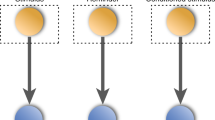Abstract
Fear memories are characterized by their permanence and a fierce resistance to unlearning by new experiences. We considered whether this durability involves a process of memory segmentation that separates competing experiences. To address this question, we used an emotional-learning task designed to measure recognition memory for category exemplars encoded during competing experiences of fear conditioning and extinction. Here, we show that people recognized more fear-conditioned exemplars encoded during conditioning than conceptually related exemplars encoded immediately after a perceptual event boundary that separates conditioning from extinction. Selective episodic memory depended on a period of consolidation, an explicit break between competing experiences, and was unrelated to within-session arousal or the explicit realization of a transition from conditioning to extinction. Collectively, these findings suggest that event boundaries guide selective consolidation to prioritize emotional information in memory—at the expense of related but conflicting information experienced shortly thereafter. We put forward a model whereby event boundaries bifurcate related memory traces for incompatible experiences. This is in contrast to a mechanism that integrates related experiences for adaptive generalization1,2,3, and reveals a potentially distinct organization by which competing memories are adaptively segmented to select and protect nascent fear memories from immediate sources of interference.
This is a preview of subscription content, access via your institution
Access options
Access Nature and 54 other Nature Portfolio journals
Get Nature+, our best-value online-access subscription
$29.99 / 30 days
cancel any time
Subscribe to this journal
Receive 12 digital issues and online access to articles
$119.00 per year
only $9.92 per issue
Buy this article
- Purchase on Springer Link
- Instant access to full article PDF
Prices may be subject to local taxes which are calculated during checkout




Similar content being viewed by others
References
Cai, D. J. et al. A shared neural ensemble links distinct contextual memories encoded close in time. Nature 534, 115–118 (2016).
Dunsmoor, J. E., Murty, V. P., Davachi, L. & Phelps, E. A. Emotional learning selectively and retroactively strengthens memories for related events. Nature 520, 345–348 (2015).
Rashid, A. J. et al. Competition between engrams influences fear memory formation and recall. Science 353, 383–387 (2016).
Pavlov, I. P. Conditioned Reflexes (Oxford Univ. Press, Oxford, 1927).
Pearce, J. M. & Hall, G. A model for Pavlovian learning: variations in the effectiveness of conditioned but not of unconditioned stimuli. Psychol. Rev. 87, 532–552 (1980).
Konorski, J. Integrative Activity of the Brain: An Interdisciplinary Approach (Univ. Chicago Press, Chicago, IL, 1967).
Bouton, M. E. Context, ambiguity, and unlearning: sources of relapse after behavioral extinction. Biol. Psychiatry 52, 976–986 (2002).
Senn, V. et al. Long-range connectivity defines behavioral specificity of amygdala neurons. Neuron 81, 428–437 (2014).
Milad, M. R. & Quirk, G. J. Neurons in medial prefrontal cortex signal memory for fear extinction. Nature 420, 70–74 (2002).
Sotres-Bayon, F., Sierra-Mercado, D., Pardilla-Delgado, E. & Quirk, G. J. Gating of fear in prelimbic cortex by hippocampal and amygdala inputs. Neuron 76, 804–812 (2012).
Tovote, P., Fadok, J. P. & Lüthi, A. Neuronal circuits for fear and anxiety. Nat. Rev. Neurosci. 16, 317–331 (2015).
Dunsmoor, J. E., Niv, Y., Daw, N. D. & Phelps, E. A. Rethinking extinction. Neuron 88, 47–63 (2015).
Brashers-Krug, T., Shadmehr, R. & Bizzi, E. Consolidation in human motor memory. Nature 382, 252–255 (1996).
Müller, G. E. & Pilzecker, A. Experimentelle Beiträge zur Lehre vom Gedächtniss Vol. 1 (JA Barth, Leipzig, 1900).
Kurby, C. A. & Zacks, J. M. Segmentation in the perception and memory of events. Trends Cogn. Sci. 12, 72–79 (2008).
Speer, N. K. & Zacks, J. M. Temporal changes as event boundaries: processing and memory consequences of narrative time shifts. J. Mem. Lang. 53, 125–140 (2005).
Rinck, M. & Bower, G. H. Temporal and spatial distance in situation models. Mem. Cogn. 28, 1310–1320 (2000).
Zacks, J. M. & Tversky, B. Event structure in perception and conception. Psychol. Bull. 127, 3–21 (2001).
Morrow, D. G., Greenspan, S. L. & Bower, G. H. Accessibility and situation models in narrative comprehension. J. Mem. Lang. 26, 165–187 (1987).
Ezzyat, Y. & Davachi, L. What constitutes an episode in episodic memory? Psychol. Sci. 22, 243–252 (2011).
Davachi, L. & DuBrow, S. How the hippocampus preserves order: the role of prediction and context. Trends Cogn. Sci. 19, 92–99 (2015).
Ezzyat, Y. & Davachi, L. Similarity breeds proximity: pattern similarity within and across contexts is related to later mnemonic judgments of temporal proximity. Neuron 81, 1179–1189 (2014).
DuBrow, S. & Davachi, L. The influence of context boundaries on memory for the sequential order of events. J. Exp. Psychol. Gen. 142, 1277–1286 (2013).
DuBrow, S. & Davachi, L. Temporal binding within and across events. Neurobiol. Learn. Mem. 134, 107–114 (2016).
Clewett, D. & Davachi, L. The ebb and flow of experience determines the temporal structure of memory. Curr. Opin. Behav. Sci. 17, 186–193 (2017).
Dudai, Y., Karni, A. & Born, J. The consolidation and transformation of memory. Neuron 88, 20–32 (2015).
Gershman, S. J., Monfils, M.-H., Norman, K. A. & Niv, Y. The computational nature of memory modification. eLife 6, e23763 (2017).
Lee, H. J., Berger, S. Y., Stiedl, O., Spiess, J. & Kim, J. J. Post-training injections of catecholaminergic drugs do not modulate fear conditioning in rats and mice. Neurosci. Lett. 303, 123–126 (2001).
Wilensky, A. E., Schafe, G. E. & LeDoux, J. E. Functional inactivation of the amygdala before but not after auditory fear conditioning prevents memory formation. J. Neurosci. 19, RC48 (1999).
McGowan, J. et al Prophylactic ketamine attenuates learned fear. Neuropsychopharmacology 42, 1577–1589 (2017).
Schiff, H. C. et al. β-Adrenergic receptors regulate the acquisition and consolidation phases of aversive memory formation through distinct, temporally regulated signaling pathways. Neuropsychopharmacology 42, 895–903 (2017).
Bush, D. E., Caparosa, E. M., Gekker, A. & LeDoux, J. β-Adrenergic receptors in the lateral nucleus of the amygdala contribute to the acquisition but not the consolidation of auditory fear conditioning. Front. Behav. Neurosci. 4, 154 (2010).
Maren, S. & Chang, C. H. Recent fear is resistant to extinction. Proc. Natl Acad. Sci. USA 103, 18020–18025 (2006).
Huff, N. C., Hernandez, J. A., Blanding, N. Q. & LaBar, K. S. Delayed extinction attenuates conditioned fear renewal and spontaneous recovery in humans. Behav. Neurosci. 123, 834–843 (2009).
McGaugh, J. L. Consolidating memories. Annu. Rev. Psychol. 66, 1–24 (2015).
Dudai, Y. The neurobiology of consolidations, or, how stable is the engram? Annu. Rev. Psychol. 55, 51–86 (2004).
Robertson, E. M., Pascual-Leone, A. & Miall, R. C. Current concepts in procedural consolidation. Nat. Rev. Neurosci. 5, 576–582 (2004).
Swallow, K. M., Zacks, J. M. & Abrams, R. A. Event boundaries in perception affect memory encoding and updating. J. Exp. Psychol. Gen. 138, 236–257 (2009).
Zacks, J. M. & Swallow, K. M. Event segmentation. Curr. Dir. Psychol. Sci. 16, 80–84 (2007).
Ben-Yakov, A., Eshel, N. & Dudai, Y. Hippocampal immediate poststimulus activity in the encoding of consecutive naturalistic episodes. J. Exp. Psychol. Gen. 142, 1255–1263 (2013).
Patil, A., Murty, V. P., Dunsmoor, J. E., Phelps, E. A. & Davachi, L. Reward retroactively enhances memory consolidation for related items. Learn. Mem. 24, 65–69 (2017).
Dunsmoor, J. E., Martin, A. & LaBar, K. S. Role of conceptual knowledge in learning and retention of conditioned fear. Biol. Psychol. 89, 300–305 (2012).
Herry, C. et al. Switching on and off fear by distinct neuronal circuits. Nature 454, 600–606 (2008).
Gallistel, C. R., Fairhurst, S. & Balsam, P. The learning curve: implications of a quantitative analysis. Proc. Natl Acad. Sci. USA 101, 13124–13131 (2004).
Rescorla, R. A. & Wagner, A. R. A Theory of Pavlovian Conditioning: Variations in the Effectiveness of Reinforcement and Nonreinforcement (Appleton-Century-Crofts, New York, NY, 1972).
Gershman, S. J., Jones, C. E., Norman, K. A., Monfils, M.-H. & Niv, Y. Gradual extinction prevents the return of fear: implications for the discovery of state. Front. Behav. Neurosci. 7, 164 (2013).
Denniston, J. C., Chang, R. C. & Miller, R. R. Massive extinction treatment attenuates the renewal effect. Learn. Motiv. 34, 68–86 (2003).
Dunsmoor, J. E., Campese, V. D., Ceceli, A. O., LeDoux, J. E. & Phelps, E. A. Novelty-facilitated extinction: providing a novel outcome in place of an expected threat diminishes recovery of defensive responses. Biol. Psychiatry 78, 203–209 (2015).
Gunther, L. M., Denniston, J. C. & Miller, R. R. Conducting exposure treatment in multiple contexts can prevent relapse. Behav. Res. Ther. 36, 75–91 (1998).
Shohamy, D. & Adcock, R. A. Dopamine and adaptive memory. Trends Cogn. Sci. 14, 464–472 (2010).
Adolphs, R. The biology of fear. Curr. Biol. 23, R79–R93 (2013).
Talmi, D. Enhanced emotional memory: cognitive and neural mechanisms. Curr. Dir. Psychol. Sci. 22, 430–436 (2013).
Plendl, W. & Wotjak, C. T. Dissociation of within-and between-session extinction of conditioned fear. J. Neurosci. 30, 4990–4998 (2010).
Gershman, S. J. & Hartley, C. A. Individual differences in learning predict the return of fear. Learn. Behav. 43, 243–250 (2015).
Craske, M. G. et al. Optimizing inhibitory learning during exposure therapy. Behav. Res. Ther. 46, 5–27 (2008).
Myers, K. M., Ressler, K. J. & Davis, M. Different mechanisms of fear extinction dependent on length of time since fear acquisition. Learn. Mem. 13, 216–223 (2006).
Golkar, A. & Öhman, A. Fear extinction in humans: effects of acquisition–extinction delay and masked stimulus presentations. Biol. Psychol. 91, 292–301 (2012).
Shiban, Y., Wittmann, J., Weißinger, M. & Mühlberger, A. Gradual extinction reduces reinstatement. Front. Behav. Neurosci. 9, 254 (2015).
Bouton, M. E. Context, time, and memory retrieval in the interference paradigms of Pavlovian learning. Psychol. Bull. 114, 80–99 (1993).
Ballarini, F., Moncada, D., Martinez, M. C., Alen, N. & Viola, H. Behavioral tagging is a general mechanism of long-term memory formation. Proc. Natl Acad. Sci. USA 106, 14599–14604 (2009).
Wang, S. H., Redondo, R. L. & Morris, R. G. Relevance of synaptic tagging and capture to the persistence of long-term potentiation and everyday spatial memory. Proc. Natl Acad. Sci. USA 107, 19537–19542 (2010).
Taylor, W. A. Change-Point Analysis: A Powerful New Tool for Detecting Changes (Taylor Enterprises, 2000); http://variation.com/cpa/tech/changepoint.html
Green, S. R., Kragel, P. A., Fecteau, M. E. & LaBar, K. S. Development and validation of an unsupervised scoring system (Autonomate) for skin conductance response analysis. Int. J. Psychophysiol. 91, 186–193 (2014).
Acknowledgements
We thank M. Monfils, J. Lewis-Peacock and the LeDoux lab for helpful comments and discussions. The study was supported by NIH R01 MH097085 (to E.A.P.). J.E.D. is supported by NIH K99R00 MH106719. M.C.W.K is supported by an H2020 Marie Sklodowska-Curie fellowship and a Society in Science—Branco Weiss fellowship. The funders had no role in the study design, data collection and analysis, decision to publish or preparation of the manuscript.
Author information
Authors and Affiliations
Contributions
J.E.D., M.C.W.K., L.D. and E.A.P. conceived and designed the study. J.E.D., C.M.M. and M.D.E. performed the research. J.E.D. and M.C.W.K. analysed the data. All authors helped to interpret the data. J.E.D., M.C.W.K., L.D. and E.A.P. wrote the manuscript. All authors contributed to and approved the final manuscript.
Corresponding author
Ethics declarations
Competing interests
The authors declare no competing interests.
Additional information
Publisher’s note: Springer Nature remains neutral with regard to jurisdictional claims in published maps and institutional affiliations.
Supplementary information
Supplementary Information
Supplementary Methods, Supplementary Results, Supplementary Tables 1–11
Rights and permissions
About this article
Cite this article
Dunsmoor, J.E., Kroes, M.C.W., Moscatelli, C.M. et al. Event segmentation protects emotional memories from competing experiences encoded close in time. Nat Hum Behav 2, 291–299 (2018). https://doi.org/10.1038/s41562-018-0317-4
Received:
Accepted:
Published:
Issue Date:
DOI: https://doi.org/10.1038/s41562-018-0317-4
This article is cited by
-
Dynamic emotional states shape the episodic structure of memory
Nature Communications (2023)
-
Active suppression prevents the return of threat memory in humans
Communications Biology (2021)
-
Event boundaries do not cause the immediate extinction deficit after Pavlovian fear conditioning in rats
Scientific Reports (2019)



